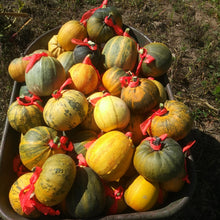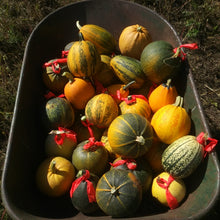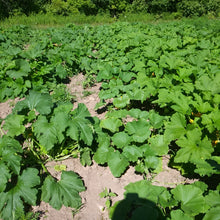'Maxidiwiac' (Buffalo Bird Woman) Summer Squash
Regular price
$4.25
Sale
Cucurbita pepo
Origin: Wisconsin
Improvement status: Breeding population
Seeds per packet: ~18
Germination tested 10/2024: 88%
Life cycle: Annual
This diverse population of summer squash was developed (and these seeds produced) by our friend Dr. Frank Kutka, a corn breeder who made a big splash in the organic plant breeding world some years ago with news of his progress on develoing GMO-pollen-resistant corn. Frank is currently a professor at the College of Menominee Nation developing a degree program in Sustainable Agriculture. We're very excited to be releasing this squash on Frank's behalf to the wider world. Here's what he has to say about it:
"I named it for Maxidiwiac (or Buffalo Bird Woman), who via her book has mentored me in the garden for many years. She specifically did not keep pure varieties of squash, but did like to slice and dry summer squash for winter meals. This beautiful bush variety will fit into most gardens and produce a diverse array of colorful and delicious summer squash great for slicing and drying [an important winter staple for indigenous farmers like Maxidiwiac], and, when fully mature, decorative little pumpkins."
Maxidiwiac's book — Agriculture of the Hidatsa Indians — which you can read in full here (https://digital.library.upenn.edu/women/buffalo/garden/garden.html), was created through a long series of dictations between 1912 and 1915, thanks to the interpretation of her son Edward Goodbird (Tsaka'kasạkic). It was transcribed by a white scholar named Gilbert Livingstone Wilson, PhD, who is credited on the original publication's title page as the author, though he writes this in the introduction: "the writer claims no credit beyond arranging the material and putting the interpreter's Indian-English translations into proper idiom. Bits of Indian philosophy and shrewd or humorous observations found in the narrative are not the writer's, but the informant's, and are as they fell from her lips. The writer has sincerely endeavored to add to the narrative essentially nothing of his own."
Despite the obviously unequal power dynamics involved in their relationship, Wilson seems to have been a highly sympathetic chronicler, and the product of his relationship with Maxidiwiac and her son is a singular and immensely valuable account of agricultural practices and cultural beliefs of a people whose traditional ways might otherwise have been lost to history (at least to those not privy to the oral histories which circulate within their communities across generations).
Of his chief "informant", Livingstone wrote in the book's 1917 introduction: "Maxi'diwiac, or Buffalobird-woman, is a daughter of Small Ankle, a leader of the Hidatsas in the trying time of the tribe's removal to what is now Fort Berthold reservation. She was born on one of the villages at Knife River two years after the 'smallpox year,' or about 1839. She is a conservative and sighs for the good old times, yet is aware that the younger generation of Indians must adopt civilized ways. Ignorant of English, she has a quick intelligence and a memory that is marvelous. To her patience and loyal interest is chiefly due whatever of value is in this thesis. In the sweltering heat of an August day she has continued dictation for nine hours, lying down but never flagging in her account, when too weary to sit longer in a chair. Goodbird's testimony that his mother 'knows more about old ways of raising corn and squashes than any one else on this reservation,' is not without probability. Until recently, a small part of Goodbird's plowed field was each year reserved for her, that she might plant corn and beans and squashes, cultivating them in old fashioned way, by hoe. Such corn, of her own planting and selection, has taken first prize at an agricultural fair, held recently by the reservation authorities."
He continues, "Edward Goodbird, or Tsaka'kasạkic, the writer's interpreter, is a son of Maxi'diwiac, born about November, 1869. Goodbird was one of the first of the reservation children to be sent to the mission school; and he is now native pastor of the Congregational chapel at Independence. He speaks the Hidatsa, Mandan, Dakota, and English languages. Goodbird is a natural student; and he has the rarer gift of being an artist. His sketches–and they are many–are crude; but they are drawn in true perspective and do not lack spirit. Goodbird's life, dictated by himself, has been recently published."
And he closes: "Agriculture of the Hidatsa Indians is not, then, an account merely of Indian agriculture. It is an Indian woman's interpretation of economics; the thoughts she gave to her fields; the philosophy of her labors. May the Indian woman's story of her toil be a plea for our better appreciation of her race."
Frank is releasing this population in the same spirit of appreciation and honor.
'Maxidiwiac' summer squash is a composite population of round, variably colored summer squash. It includes European heirlooms like 'Ronde de Nice' from France, and 'Botsman' and 'Kolobok' (the latter of which Frank calls "outrageously vigorous") from Belarus, along with — quite appropriately for a squash named after Maxidiwiac — 'Striped Mandan', an heirloom from the Mandan people, close cousins of Maxidiwiac's Hidatsa people, and likely quite similar to squash with which Maxidiwiac would have been familiar. The selection to generate this population has been for earliness, bush form and colors. Frank says, "My hope was to find beautiful round squash I could fry with garlic and to find well-behaved plants that would produce nice slicers for drying as Maxidiwiac did, but the fruits of these bush plants also mature into multicolored novelty pumpkins. Fun is sure to be had."
We certainly hope you agree.






